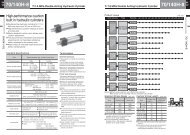70/140H-8 Series (2310KB) - TAIYO
70/140H-8 Series (2310KB) - TAIYO
70/140H-8 Series (2310KB) - TAIYO
You also want an ePaper? Increase the reach of your titles
YUMPU automatically turns print PDFs into web optimized ePapers that Google loves.
37<br />
Precautions for use<br />
Precautions<br />
for use<br />
(2) Rotary type<br />
● For the cylinder of which mounting part moves inside<br />
a plane, be sure to connect the connection fittings of<br />
the rod end with pins, so that the mounting part can<br />
move inside the plane. For the plane and rectangular<br />
direction, perform centering similarly to the fixed type.<br />
● Be sure to apply lubricant to the bearing part of the<br />
connection fittings.<br />
● DO NOT use floating joints for rod end attachments.<br />
➀ CA, CB, TA, and TC type attachments<br />
● Use pins of the size specified in this catalogue.<br />
● In the case of a long stroke (1000 mm or longer),<br />
avoid horizontal mounting. Otherwise, a lateral<br />
load is applied to the bush part due to the weight<br />
of the cylinder, causing uneven abrasion, substantially<br />
shorter service life, or galling.<br />
➁ TA, TC type attachments<br />
Mount counterpart attachments so that they are<br />
vertical with the trunnion boss. If they are mounted<br />
slantingly, uneven abrasion may occur in the boss<br />
bearing area, causing a substantially shorter service<br />
life.<br />
5. Piping<br />
● Take sufficient care to avoid dusts and chips of pipes<br />
in the piping.<br />
● When piping, avoid any air accumulation in pipes.<br />
● When connecting with a rubber hose, do not bend it<br />
with the bending radius smaller than the specified level.<br />
● Be sure to perform piping flushing. After flushing is<br />
complete, connect to the cylinder. Otherwise, the<br />
cylinder may be malfunctioned or oil leak may occur<br />
due to dusts in the piping.<br />
6. Other notes<br />
● When welding near a cylinder, it may be subjected<br />
with spatters. Protect the cylinder rod to avoid<br />
spatters.<br />
● When welding during mounting, take sufficient care to<br />
avoid an electric current in the cylinder. Any electric<br />
current in the cylinder may lead to arcs between the<br />
rod and bush or between the piston and tube, causing<br />
the damaged cylinder parts.<br />
● After mounting is complete, be sure to perform air vent<br />
and cushion adjustment. For the adjustment<br />
methods, follow the descriptions in “7. Operation”.<br />
Prior to the use of cylinders, be sure to read<br />
carefully the precautions below.<br />
7. Operation<br />
● Trial run (before operation)<br />
7-1) Air vent<br />
(1) Feed oil of low pressure (the pressure that the<br />
cylinder moves at a low speed, approx. 10 mm/s) to<br />
the cylinder, and vent air in oil from the check valve<br />
or air vent plug.<br />
● At this time, if the check valve is excessively<br />
loosened, it may be come off from the cylinder,<br />
causing spouted oil and serious accidents.<br />
● Repeat the step above until no air remains in the<br />
pipe.<br />
● Exhaust air in the piping, as well as that in the<br />
cylinder. Any air remained may cause malfunctions<br />
below.<br />
[Symptoms]<br />
a) Stick slip<br />
b) Unsmooth speed control<br />
c) Damaged packings due to increased temperature<br />
caused by adiabatic compression<br />
d) Shock or vibration occurs to outside<br />
e) Impossibility of set output<br />
● When a cylinder<br />
moves forward<br />
Loosen the check valve<br />
on the rod side<br />
ON<br />
CAUTION<br />
● If the piston speed is fast from the beginning,<br />
abnormal surge pressure may occur, causing the<br />
damaged cylinder or machine.<br />
CAUTION<br />
Overloosening of the check valve during the air vent<br />
may lead to the coming-off of the check valve from<br />
the cylinder, causing spouted oil and serious<br />
accidents.<br />
● When a cylinder<br />
moves backward<br />
Loosen the check valve<br />
on the head side<br />
OFF




